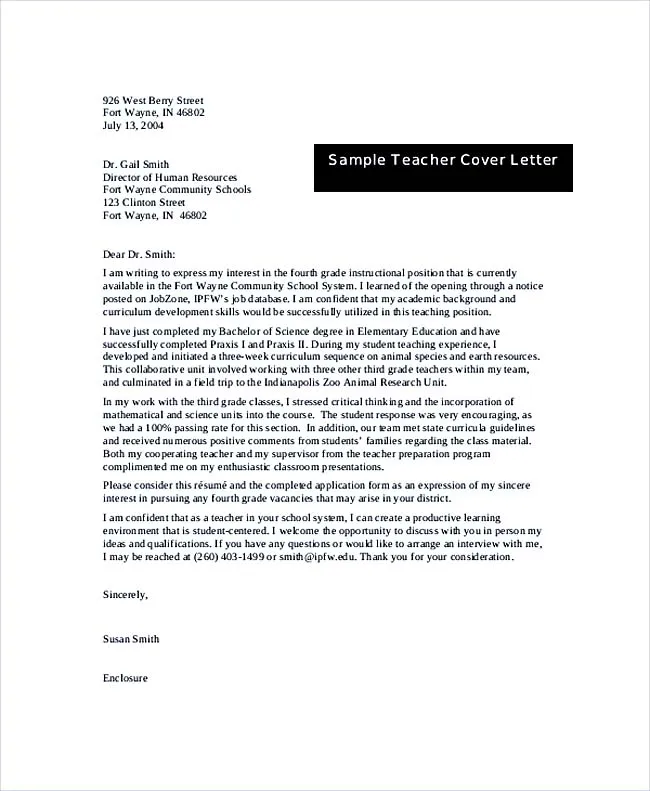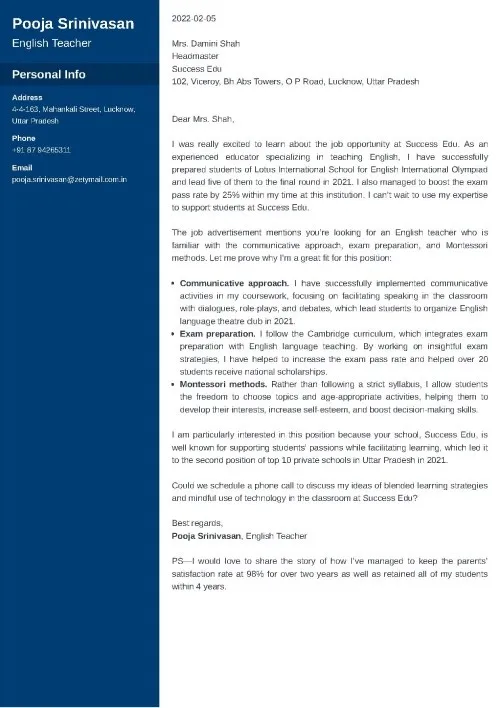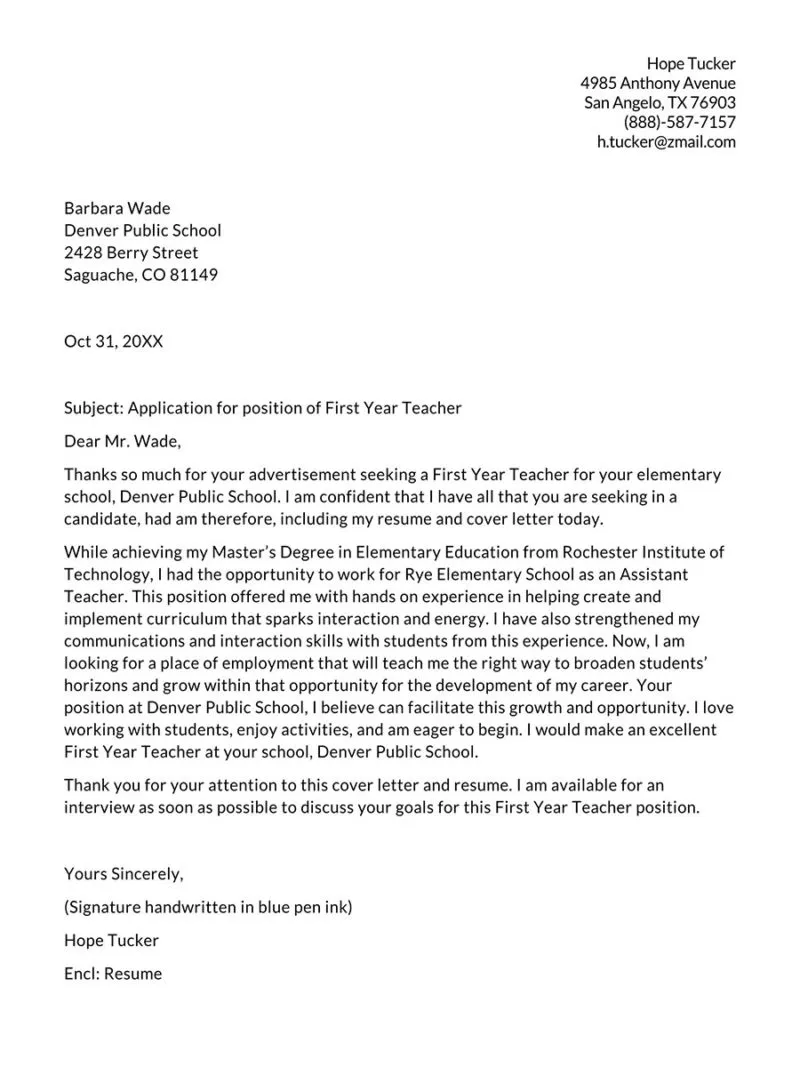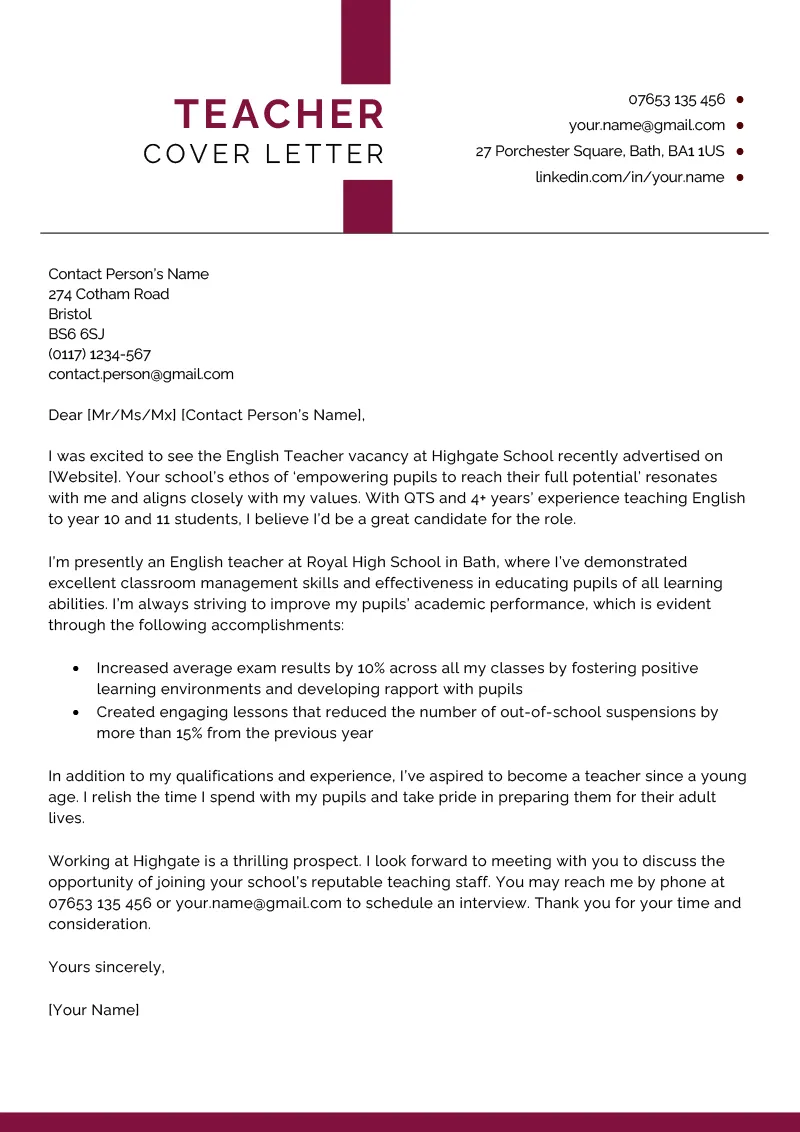What is a Cover Letter for Teaching Job
A cover letter for a teaching job is more than just a formality; it’s your first chance to make a strong impression on a potential employer. It serves as an introduction, a personal statement, and a marketing tool, all rolled into one. This document allows you to highlight your qualifications, showcase your passion for education, and demonstrate why you’re the perfect fit for the specific teaching position. Unlike a resume, which provides a factual overview of your experience and skills, the cover letter gives you the space to tell your story and connect with the hiring manager on a more personal level. A well-crafted cover letter can significantly increase your chances of landing an interview and ultimately, securing your dream teaching job. It’s your opportunity to make yourself stand out from the crowd and leave a lasting positive impact.
Purpose of a Cover Letter
The primary purpose of a cover letter is to introduce you to the hiring committee and express your interest in a specific teaching position. It provides a narrative that complements your resume, elaborating on your experiences, skills, and qualifications. It demonstrates your understanding of the school’s values, the specific needs of the role, and how you can contribute to the educational environment. Furthermore, a cover letter allows you to showcase your personality, teaching philosophy, and enthusiasm for the subject matter and age group you wish to teach. It serves as a platform to explain any gaps in your resume or unique circumstances that might require clarification. Overall, it’s a crucial tool in presenting yourself as a well-rounded and suitable candidate for the teaching position. A strong cover letter can turn you from an applicant into a highly considered candidate.
Key Components of a Cover Letter for Teaching

A winning cover letter for a teaching job comprises several key elements, each designed to communicate your qualifications and suitability effectively. These components work together to paint a comprehensive picture of you as an educator and demonstrate your understanding of the role and the school. Each part plays a specific role in telling your story and selling your abilities. You can create an outstanding cover letter by understanding and executing these aspects.
Header
The header of your cover letter should include your contact information: your name, address, phone number, and email address. This ensures that the hiring manager can easily reach you. Ensure that the information is up-to-date and professional. If you are applying via email, you might include this information in the signature of your email. The header sets the professional tone of your application, making it easy for the recipient to contact you regarding the position. Using a clean and professional format is essential.
Salutation
Begin your cover letter with a formal salutation, such as “Dear Mr./Ms./Dr. [Last Name]”. If you know the name of the hiring manager, it’s best to address the letter directly to them; this shows that you’ve done your research and that you’re paying attention to detail. If you can’t find a specific name, use a general greeting like “Dear Hiring Committee” or “Dear Principal.” Avoid using overly casual greetings such as “Hello” or “Hi.” The salutation sets the tone of your letter and shows your respect for the recipient.
Opening Paragraph

The opening paragraph is your first opportunity to grab the reader’s attention. State the specific teaching position you’re applying for and where you saw the job posting. Briefly express your enthusiasm for the role and the school. Mention a key skill or experience that makes you an ideal candidate. Your opening should be concise, engaging, and designed to immediately capture the reader’s interest. This paragraph should quickly convey your passion and match for the position, while also getting the reader engaged in wanting to know more about your qualifications.
Body Paragraphs
The body paragraphs are where you highlight your skills, experience, and teaching philosophy. Use these paragraphs to elaborate on your qualifications and connect them to the requirements of the teaching job. Provide specific examples to demonstrate your teaching abilities and impact. Tailor your response to the unique characteristics of the school and the role. You can show your abilities and match for the school by including details that are relevant to the specific requirements of the job posting. Make sure the body paragraphs are well-organized, engaging, and showcase your value as a teacher.
Highlighting Skills and Experience
In the body paragraphs, focus on the skills and experiences that align with the job description. Use action verbs to describe your accomplishments and quantify your results whenever possible. For instance, instead of saying “I taught students,” say “I implemented differentiated instruction strategies that increased student engagement by 20%.” Showcase your knowledge of curriculum development, classroom management, and assessment methods. Tailor the skills and experiences you highlight to match the specific requirements and preferences of the school. This will demonstrate your ability to meet the needs of the students and contribute to the success of the school’s educational objectives.
Demonstrating Passion for Education

Express your enthusiasm for teaching and your dedication to student success. Share your teaching philosophy and what inspires you to educate young minds. Give details of how you foster a positive and inclusive learning environment. Demonstrate your commitment to continuous professional growth and a lifelong passion for learning. Include details of any volunteer work or involvement with school-related activities. Show that you care about their success beyond their academic abilities and your personal enjoyment from teaching. Your passion for education should be evident in every paragraph and should resonate with the reader.
Tailoring to the Specific Job
Customize your cover letter to the specific teaching job by reviewing the job description and aligning your qualifications. Show that you understand the school’s mission, values, and needs. Mention specific programs, initiatives, or teaching methods that resonate with the school’s approach to education. You could also highlight your knowledge of the local school district and any challenges or opportunities the school faces. This helps you demonstrate your detailed research and genuine interest in the specific position and school. It shows that you’re not sending out a generic letter and that you’re truly interested in being part of their educational community.
Closing Paragraph
In your closing paragraph, summarize your key qualifications and reiterate your enthusiasm for the teaching job. Express your gratitude for the hiring committee’s time and consideration. Reaffirm your interest in the position and let them know that you’re available for an interview. This is your final chance to leave a positive impression and to thank the reader for their time. Keep your conclusion brief, professional, and confident, letting the hiring manager know how you can contribute.
Call to Action

End your cover letter with a clear call to action. State your availability for an interview and express your eagerness to discuss your qualifications further. Provide your contact information again, just in case it’s needed. A strong call to action encourages the hiring manager to move forward with the interview process. Be clear and proactive, showing that you are ready and willing to take the next steps.
Formatting and Proofreading the Cover Letter
The appearance of your cover letter is just as important as its content. Proper formatting and thorough proofreading can significantly improve your chances of making a positive impression and securing an interview. Ensure your cover letter reflects professionalism and attention to detail by following these guidelines.
Font and Layout
Choose a professional, easy-to-read font, such as Times New Roman, Arial, or Calibri, and maintain a consistent font size (usually 11 or 12 points). Use standard margins (1 inch on all sides) and single-spacing throughout the document. Break up large blocks of text with short paragraphs and use bullet points to highlight key information. Ensure the layout is clean, organized, and visually appealing. A well-formatted cover letter is easy to read, which shows your respect for the reader’s time. A consistent and tidy layout helps the reader focus on your message.
Proofreading and Editing

Proofread your cover letter carefully for any errors in grammar, spelling, and punctuation. These mistakes can create a negative impression and undermine your credibility. Have a friend, family member, or career counselor review your cover letter to catch any errors you may have missed. Ensure that your writing is clear, concise, and free of jargon or overly complex sentences. Edit your writing to make sure your message is easy to understand and gets the point across. The goal is to present a polished, professional document that reflects your attention to detail and commitment to excellence.
Examples of Effective Cover Letters
Studying examples of effective cover letters can provide valuable insights into the structure, content, and tone that resonate with hiring managers. Look for examples that match your experience level, subject area, and teaching philosophy. Pay attention to how the examples showcase accomplishments, skills, and passion for teaching. Adapt the best practices from these examples to create a unique and persuasive cover letter. The following can be examples to guide you with your teaching cover letter:
- Seek sample cover letters tailored to the specific type of teaching jobs, like elementary, middle school, or high school.
- Pay attention to how other teachers highlight their accomplishments using action verbs and specific examples.
- Analyze the tone and style of the letter to match the school’s culture and the job description.
- Focus on how they adapt their letters to match the specific requirements and needs of the different job requirements.
Things to Avoid in a Cover Letter
Certain aspects can seriously diminish your chances of being considered for a teaching job. Avoiding these mistakes can help you create a compelling and professional cover letter. It is important to stay away from these aspects to improve your chance of being considered.
- Avoid generic or template letters
- Refrain from using slang or unprofessional language
- Do not include irrelevant information
- Avoid negative or critical statements
- Don’t exceed the length of one page
By following these guidelines and tailoring your cover letter to each specific job, you will significantly enhance your chances of landing an interview and securing your dream teaching position. Good luck with your application!
